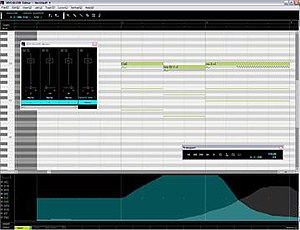Vocaloid 2
 |
|
| Original author(s) | Yamaha Corporation |
|---|---|
| Developer(s) | Yamaha Corporation, Bplats |
| Initial release | June 29, 2007 |
| Stable release |
2.0.12 / November 6, 2010
|
| Development status | Retired |
| Operating system | Microsoft Windows |
| Available in | English and Japanese |
| Type | Vocal Synthesizer Application |
| License | Proprietary |
| Website | www |
Vocaloid 2 is a singing voice synthesizer and successor to Vocaloid in the Vocaloid series. It gained unexpected success and cultural impact following its release.
Vocaloid 2 was announced in 2007. Unlike the first engine, Vocaloid 2 based its results on vocal samples, rather than analysis of the human voice. Due to time constraints, unlike the previous engine version, it did not have a public beta test and instead the software was updated as users reported issues with it. The synthesis engine and the user interface were completely revamped, with Japanese Vocaloids possessing a Japanese interface. New features such as note auditioning, transparent control track, toggling between playback and rendering, and expression control were implemented. One's breath noise and husky voice can be recorded into the library to make realistic sounds. This version is not backward compatible and its editor cannot load a library built for the previous version. Aside from the PC software, NetVocaloid services are offered. Despite this, the software was not localized and Vocaloids of either English or Japanese would only possess that language version, so although Megurine Luka had an English library included, as a Japanese Vocaloid she only had access to the Japanese version of the software. In total, there were 17 packages produced for Vocaloid 2 in the Japanese version of the software and five in the English version; these packages offered 35 voicebanks between them in either English or Japanese.
Yamaha announced a version of the Vocaloid 2 software for the iPhone and iPad, which exhibited at the Y2 Autumn 2010 Digital Content Expo in Japan. Later, this version of the software was released using the voice of Yamaha's own Vocaloid called VY1. These products were launched as iVocaloid and i-Vocaloid, though the latter was later renamed to VocaloWitter.
The Hatsune Miku product in particular went on to win several awards including;
Unlike the original Vocaloid software, Vocaloid 2 vocals could be imported into Vocaloid 3. However, because they lacked a Mac version entirely, it was not possible to import any Vocaloid 2 vocal into either the Vocaloid Neo or any of the Vocaloid Editor for Cubase Mac adaptions. Importation into Vocaloid 4 was also possible by either importing into Vocaloid 3 then Vocaloid 4 or via use of the Vocaloid 2 import tool. Also while VSTi plug-in support for the software was provided, Vocaloid 2 would not work with digital audio workstations such as Sonar and had trouble with others such as Fl Studio.
...
Wikipedia
